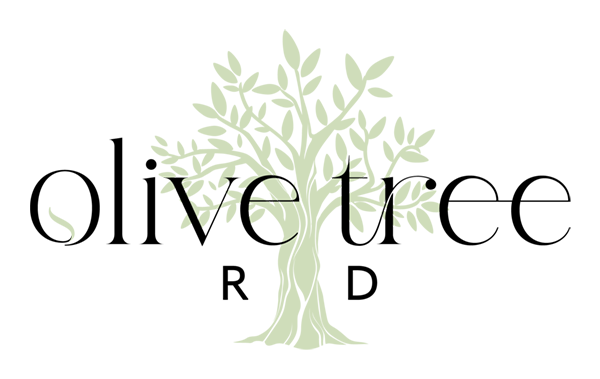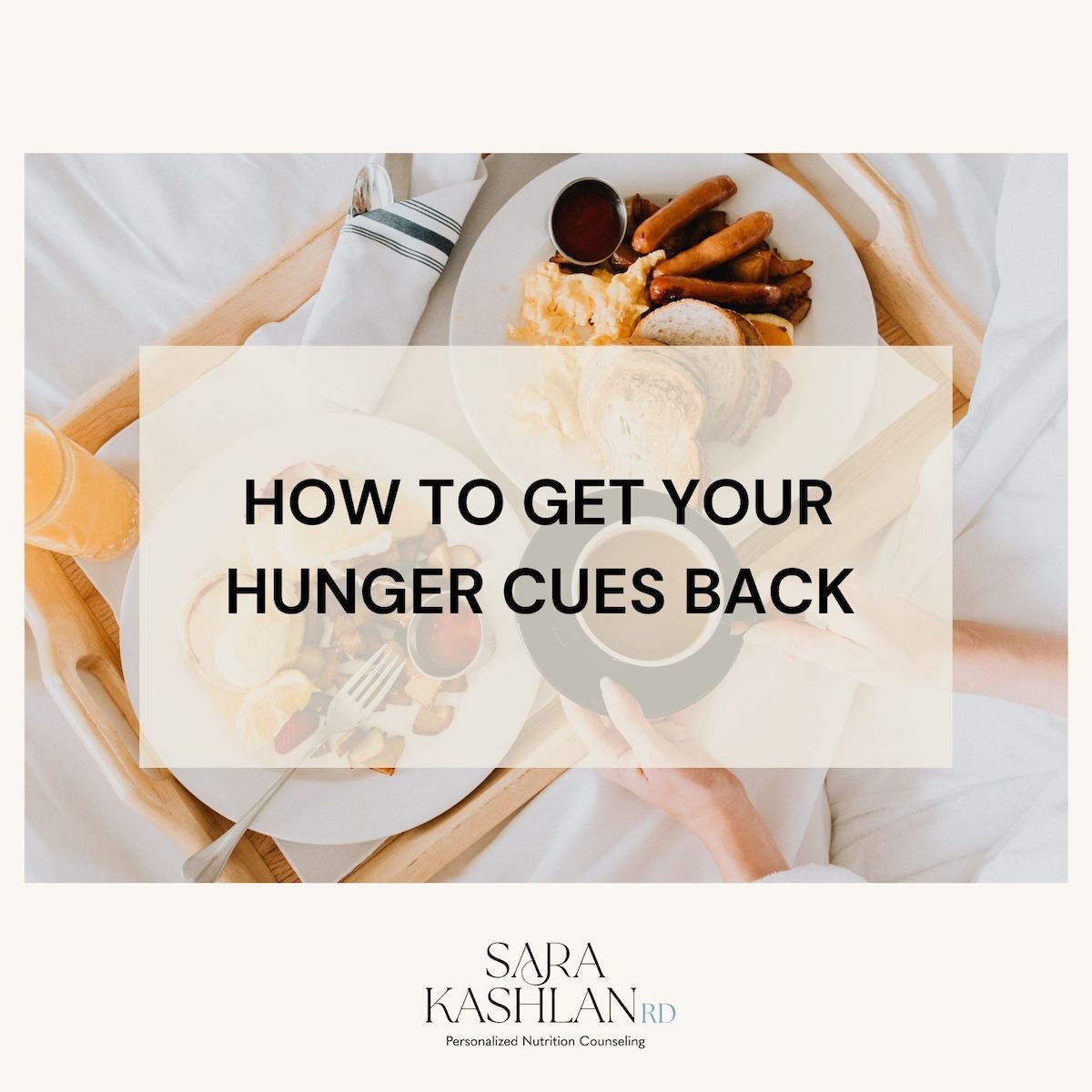How to Get Hunger Cues Back
Are you struggling with trusting your hunger signals?
Perhaps you have no hunger cues at the moment and are feeling frustrated as you navigate intuitive eating?
I get it! Losing these signals is common when there are so many external factors impacting them!
This post will explain how to get those cues back with four simple steps.
Let’s get started!
What Causes Hunger Cues to Go Away?
If you feel completely out of touch with signs of hunger and fullness, you are not alone. Many of my clients initially come to me saying the exact same thing. If you have a history of chronic dieting or eating disorder behaviors, such as binge eating, purging or overexercising, then it’s possible that your body will stop sending you normal signals.
There is so much disordered advice out there telling us precisely what to eat versus what to avoid, how much you “should” eat, and at what specific time. If you find yourself relying on these external factors, that alone can cause a lot of stress to your body, which can also impact your sleep and overall mess with your internal cues.
What’s even more frustrating is that so much diet advice out there is sending conflicting messages. Don’t believe me? Take a look at this roundup of diet “advice” I’ve heard over the years…
Did your head hurt just now from reading the photo above? Yeah, me too. Diets are designed to fail so that the consumer blames themselves and their bodies, only to then spend even more money as they transition to the next diet. That’s why diet culture businesses are worth billions of dollars. Cringe, right?!
With all of this in mind, it’s no wonder hunger signals turn off! Our relationship with our bodies is no different than our relationship with others - we have to show up consistently, listen, and build trust in order to have a long lasting relationship. If you rely on external factors, like calories, points, food or weight scales, or other dieting tools instead of your body, well, your body will ghost you, too.
Benefits to Getting Hunger Cues Back
You might be afraid of getting your hunger cues back. Our diet-obsessed society sells the message that you cannot trust these signals and that you need to suppress them at all costs. Well, guess what? Having hunger cues is not a bad thing — it’s normal and good to be hungry every few hours! It’s our body’s way of telling us our metabolism is working.
Getting your hunger cues back will help you re-establish trust with your body. You can finally quiet the noise that’s yelling at you or making you feel guilty for eating. Believe it or not, this will then help you become less fixated around food and feel more satisfied.
When you honor your hunger, you’ll have more energy to do the things most important to you. Can you imagine everything else you can accomplish when your mind isn’t wrapped around food all day?! All in all, having hunger cues will improve your mood and you’ll ultimately feel more at peace.
Is it Possible to Get Your Cues Back?
The good news is you are fully capable of getting your hunger and fullness signals back and become an intuitive, flexible eater again.
We are all born as intuitive eaters. We cry when we’re hungry and we push food away or spit it out when full. As we grow up, we get bombarded with messages from the media that are promoting disordered behaviors, but luckily getting back in touch with your body is absolutely possible.
How Long Does it Take to Get Hunger Cues Back?
Everyone’s journey is going to be different based on how long they have been dieting or engaging in eating disorder behaviors. Following my 4 steps below should help you get your cues back. Patience, young grasshopper!
How to Get Hunger Signals Back
Release Your Rigidity
Our diet-obsessed society preaches the message that you cannot trust your body’s cues. Instead, diet culture makes you believe that you need to rely on calorie counting apps, points, food scales or other diet measures to figure out how much you “should” or “shouldn’t” eat. These rigid practices are holding you back from becoming in touch with your body’s inner wisdom.
If you’re not sure whether or not you are hanging on to rigid rules around food and/or your body, here are some examples:
“I have to stop eating by [insert time here].”
“I have to fast for X long.”
“I can only eat X amount of calories per day.”
“I need to weigh myself daily to know I’m okay. If I am up even a pound, my day is ruined.”
“When I eat something outside of my food plan, I get so angry with myself.”
“I can only eat [insert fear food here] X times per day/week/month/year.”
“I do not allow myself to eat specific food groups out of fear of weight gain.”
When you let go of these strict rules, you are literally sending your mind and body the message that you are going to lean in and practice loving kindness. I know how scary this might initially feel. It’s like freefalling and not knowing who or what is going to catch you. With practice, giving yourself permission to eat without food rules will become easier.
2. Consistency is Key
Once you’ve let go of that internal food police, it’s time to create a gentle routine around eating. The idea here is to be on a food schedule, eating every 2-4hours. You might be thinking, “seriously?! That seems like way too much!”
The reason I’m recommending a consistent food schedule is because blood sugar tends to dip the longer we go without sustenance. If you end up waiting too long, it might lead to something I call “binge energy”, meaning it’s not a full blown binge but you feel you need to eat whatever is in front of you, and fast.
So in order to refrain from feeling out of control around food, you’ve got to be consistent with meals and snacks. The more consistent you are, the sooner your metabolism will pick back up and get your hunger cues back.
An example of what this might look like is:
8am Breakfast
10am Snack
1pm Lunch
3pm Snack
7pm Dinner
9pm Snack
3. Start Tuning into Your Body
In order to get your hunger cues back, it’s important to start noticing the certain signs your body is sending to you before it’s time for a meal or a snack. Most people assume hunger is simply the rumbling or growling feeling in your stomach. The reality is that we initially get hunger cues in other areas before it gets to our stomachs!
Signs of hunger include:
Energy: weak, tired, sleepy, numb
Mood: low, irritable, hangry, cranky, snappy
Head: struggling to concentrate, thinking about food, light-headed, nauseous, dizzy
Body: shaky, low blood sugar, salivating, weak
Stomach: rumbling, gurgling, growling, poking, stomach ache, emptiness
Try to identify what your energy level, mood, head, body or stomach are saying to you the next time it’s time for a scheduled meal or snack. Even if you’re just able to identify one of these things, it’s considered a big win!
4. Use the Hunger & Fullness Scale
The last step in this process is using a hunger and fullness scale in order to decipher what your body is telling you before and after a meal or snack. A hunger fullness scale is a tool that helps you become more mindful and aware of when you need sustenance and when it’s time to stop.
You might feel super unsure as you begin to navigate this part & that is absolutely okay. In fact, it’s part of the process. Remember, everyone was an intuitive eater at one point in their lives. Diet culture may have steered you away from this but you can absolutely get back to it. Continue to rely on this scale until you feel confident trusting your body without it.
Bottom Line: Will your hunger cues come back?
Diet culture has unfortunately led many people astray from trusting their body’s innate wisdom. Remember, the diet industry profits off of people’s insecurities! Getting your hunger cues back and learning to trust your body might take some time, but the reward is something you’ll have for the rest of your life - freedom!
You can get your hunger cues back as long as you let go of rigidity, eat consistently throughout the day, tune into various internal signals and use the hunger & fullness scale. Best of luck in your recovery process!





